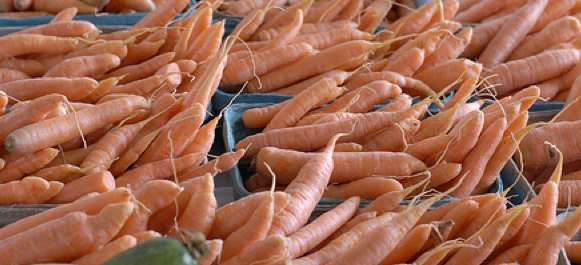 Photo Credit: Kate NG SommersPerhaps you shop at the local coops and look for that label on all of your purchases. But with a limited budget, maybe you’ve wondered what makes the most sense to buy organic. As a nutritionist working with people to improve the quality of their diet, I get asked this question a lot. So here are six suggestions for prioritizing your spending to maximize your dollars and your health.
Photo Credit: Kate NG SommersPerhaps you shop at the local coops and look for that label on all of your purchases. But with a limited budget, maybe you’ve wondered what makes the most sense to buy organic. As a nutritionist working with people to improve the quality of their diet, I get asked this question a lot. So here are six suggestions for prioritizing your spending to maximize your dollars and your health.
1. Vegetables and Fruits
I picked up my last crop share for the season last month, so I’m back to buying my produce at the store. I really appreciate the research of The Environmental Working Group who tests produce for pesticide residues. They even have a handy little wallet card you can download and an app for your iPhone.
The Environmental Working Group has designated the following produce as “The Dirty Dozen” because they consistently have the highest pesticide residues, so whenever possible, buy these organic: peach, apple, bell pepper, celery, nectarine, strawberry, cherries, kale, lettuce, imported grapes, carrot, pears. On that same card they list the “Clean 15” with the lowest pesticide residues. These are the ones you may decide to buy from conventional growers: onion, avocado, sweet corn, pineapple, mango, asparagus, sweet peas, kiwi, cabbage, eggplant, papaya, watermelon, broccoli, tomato, sweet potato. (Although regular potatoes didn’t make the Dirty Dozen list because they rank 15th on the list, people eat potatoes often so I suggest buying them organic; that way you can feel good about eating the high-fiber peels).
2. Dairy products
Of all the animal products we consume, these are often eaten most frequently. They include milk, yogurt, cheese, butter, ice cream, sour cream, half and half, and heavy cream. Dairy products sourced from organic farms like Cedar Summit avoid production methods that use daily supplemental hormones, antibiotics, feed contaminated with pesticides and herbicides, and provide more humane treatment of the animals.
3. Meat and poultry
If your budget allows, buying these organic and from local farmers provides the same benefits I mentioned in the dairy products section. Although organic meats are more expensive, we also don’t need to eat the large portions that many Americans are used to. Imagine your plate in 4 quadrants with half the plate filled with veggies, a quarter of your plate with a healthy starch like winter squash or wild rice, and the other quarter with your protein (this works out to be about 3-4 ounces). From a heart health and cancer prevention viewpoint, it’s also a good idea to eat more meatless meals and keep your beef intake to once or twice a week.
4. Peanut butter
Over 90% of peanut farms use conventional farming practices, including the use of a fungicide to treat mold, a common problem in peanut crops. If you have a child who eats peanut butter sandwiches almost every day, it’s a good idea to buy organic peanut butter and store it in the refrigerator.
5. Catsup
Some families use a lot of this condiment and recent research has shown organic catsup has twice the antioxidants of conventional catsup.
6. Baby food
If you’re not going to make your own, then it’s a good idea to buy organic. Our bodies and brains grow faster from infancy to age three than any other time in our lives. Babies also eat more than adults, pound for pound, and are more vulnerable to environmental toxins. Some reputable brands include Tasty Baby, Plum Organics, Homemade Baby, and Earth’s Best. But Sweet Cheeks Baby food is our favorite, made from locally produced, organic vegetables.
I always like to include a recipe, so although Hanukkah is over, you don’t need to wait another year to make these delicious potato-beet-celery root pancakes adapted from a recipe from Stuart and Heidi Woodman. They’re great served with a dollop of sour cream or Greek-style yogurt and some homemade applesauce!
 Potato Beet Pancakes
Potato Beet Pancakes
Ingredients:
- 3 large Russet potatoes, peeled
- 1 beet, about the size of a medium apple, peeled
- 1 celery root, peeled
- 1 large onion
- 1 egg, beaten
- 2 tbsp flour
- Salt and fresh ground pepper
Grate the potatoes and place in a bowl. Let set while you grate the beet and celery root and place them together in a separate large bowl. Now squeeze the liquid from the potatoes with your hands, letting the liquid drip back into the bowl. As you squeeze the liquid from the potatoes, place them in the large bowl with the beet and celery root. When you’re done squeezing all the liquid from the potatoes you will have a bowl full of potato liquid; let that set for a few minutes while you stir the egg and flour into the grated veggies. Add about 2-3 tsp salt and some pepper. Carefully pour off the liquid in the potato bowl; at the bottom of the bowl will be a thick white paste which is the potato starch; stir that into the veggie mixture and mix well. This helps hold the pancakes together.
For each pancake drop about 1/3 cup of the mixture into hot canola oil. Fry on each side a few minutes until browned and crispy. Drain on paper towels and eat hot!
Sharon Lehrman, MPH, RD, LD is a registered dietitian with a private practice and corporate wellness business in Minneapolis, Minnesota. You can subscribe to her monthly nutrition newsletter at www.NutritionHealthandWellness.com



